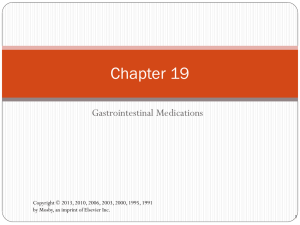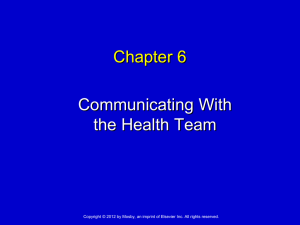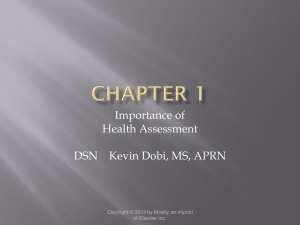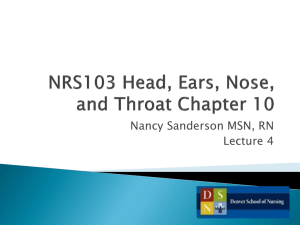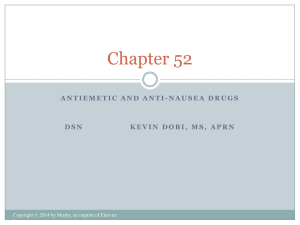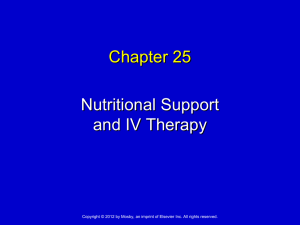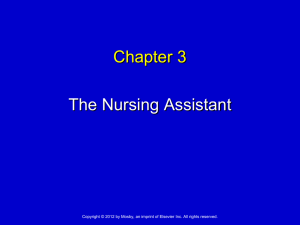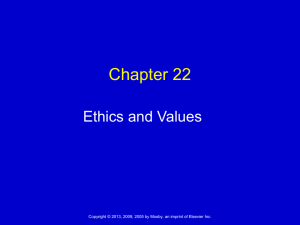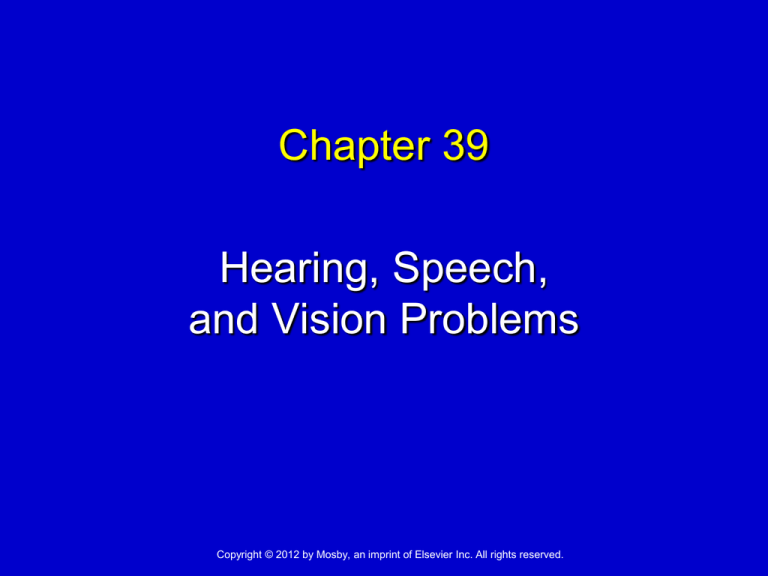
Chapter 39
Hearing, Speech,
and Vision Problems
Copyright © 2012 by Mosby, an imprint of Elsevier Inc. All rights reserved.
Hearing, Speech, and Vision
Hearing, speech, and vision
Allow communication, learning, and moving about
Are important for self-care, work, and most activities
Are important for safety and security needs
Many people have some degree of hearing or
vision loss.
Common causes are:
• Birth defects
• Accidents
• Infections
• Diseases
• Aging
Copyright © 2012 by Mosby, an imprint of Elsevier Inc. All rights reserved.
Slide 2
Ear Disorders
Otitis media is infection of the middle ear.
Viruses and bacteria are causes.
Otitis media is acute or chronic.
• Chronic otitis media can damage the tympanic membrane
(ear drum) or the ossicles.
Theses structures are needed for hearing.
Permanent hearing loss can occur.
Signs and symptoms include:
• Pain (earache) and hearing loss
• Fever and tinnitus (a ringing, roaring, hissing, or buzzing
sound in the ears or head)
Treatment involves:
• Antibiotics
• Drugs for pain relief
• Drugs to relieve congestion
Copyright © 2012 by Mosby, an imprint of Elsevier Inc. All rights reserved.
Slide 3
Ear Disorders (cont’d)
Ménière’s disease involves the inner ear.
It is a common cause of hearing loss.
Usually one ear is affected.
Symptoms include:
• Vertigo (dizziness)
• Tinnitus
• Hearing loss
• Pain or pressure in the affected ear
There is increased fluid in the inner ear.
Symptoms are sudden.
An attack can last several hours.
Copyright © 2012 by Mosby, an imprint of Elsevier Inc. All rights reserved.
Slide 4
Ear Disorders (cont’d)
Treatment involves:
• Drugs
• Fluid restriction
• A low-salt diet
• No alcohol or caffeine
Safety is needed during vertigo.
• The person must lie down.
• Falls are prevented.
• The person’s head is kept still.
• Sudden movements are avoided.
• Bright or glaring lights are avoided.
• The person should not walk alone.
Copyright © 2012 by Mosby, an imprint of Elsevier Inc. All rights reserved.
Slide 5
Ear Disorders (cont’d)
Hearing loss is not being able to hear the
normal range of sounds associated with
normal hearing.
Losses are mild to severe.
• Deafness is hearing loss in which it is impossible for
the person to understand speech through hearing
alone.
Hearing loss occurs in all age-groups.
Common causes of hearing loss are damage to
the:
• Outer, middle, or inner ear
• Acoustic nerve
Copyright © 2012 by Mosby, an imprint of Elsevier Inc. All rights reserved.
Slide 6
Ear Disorders (cont’d)
Risk factors that can damage the ear structures
include:
• Aging
• Exposure to very loud sounds and noises
• Drugs (antibiotics, too much aspirin)
• Infections
• Reduced blood flow to the ear caused by high blood
•
•
•
•
•
pressure, heart and vascular diseases, and diabetes
Stroke
Head injuries
Tumors
Heredity
Birth defects
Copyright © 2012 by Mosby, an imprint of Elsevier Inc. All rights reserved.
Slide 7
Ear Disorders (cont’d)
Temporary hearing loss can occur from earwax (cerumen).
Hearing is required for:
• Clear speech
• Responding to others
• Safety and awareness of surroundings
A person may not notice gradual hearing loss.
Others may notice obvious signs and symptoms of hearing
loss (leans forward during conversations, has inappropriate
answers).
• The person may feel left out, become suspicious, and
have slurred speech
• Older clients tend to lose high-pitched sounds
Copyright © 2012 by Mosby, an imprint of Elsevier Inc. All rights reserved.
Slide 8
Ear Disorders (cont’d)
Hearing is needed for speech.
• Hearing loss may result in slurred speech.
• Words may be pronounced wrong.
• Some persons have monotone speech or drop word
endings.
It may be hard to understand what the person says.
•
Persons with hearing loss may:
• Wear hearing aids or lip-read (speech-read)
• Watch facial expressions, gestures, and body language
• Learn American Sign Language (ASL)
Some people have hearing assistance dogs (hearing
dogs).
• The dog alerts the person to sounds.
Phones, doorbells, smoke detectors, alarm clocks, sirens,
and on-coming cars
Copyright © 2012 by Mosby, an imprint of Elsevier Inc. All rights reserved.
Slide 9
Ear Disorders (cont’d)
Hearing aids fit inside or behind the ear.
They make sounds louder.
They do not correct, restore, or cure hearing problems.
The person hears better because the device makes sounds
louder.
Background noise and speech are louder.
If a hearing aid does not seem to work properly, try
these measures.
Check if the hearing aid is on. It has an on and off switch.
Check the battery position.
Insert a new battery if needed.
Clean the hearing aid-the person should not use hairspray
Copyright © 2012 by Mosby, an imprint of Elsevier Inc. All rights reserved.
Slide 10
Speech Disorders
Speech disorders result in impaired or
ineffective oral communication.
Common causes include:
Hearing loss
Developmental disabilities
Brain injury
These problems are common:
Aphasia-cannot understand language
Apraxia-cannot use speech muscles
Dysarthria-difficult or poor speech
Copyright © 2012 by Mosby, an imprint of Elsevier Inc. All rights reserved.
Slide 11
Speech Disorders (cont’d)
The person with apraxia of speech cannot use
the speech muscles for understandable speech.
• The person understands speech and knows what to
•
say.
The brain cannot coordinate the speech muscles to
make the words.
The motor speech area in the brain is damaged.
•
Dysarthria means difficult or poor speech.
• It is caused by nervous system damage.
• Mouth and face muscles are affected.
• Slurred speech, speaking slowly or softly, hoarseness,
and drooling can occur.
Copyright © 2012 by Mosby, an imprint of Elsevier Inc. All rights reserved.
Slide 12
Speech Disorders (cont’d)
Some persons need speech rehabilitation.
• The goal is to improve the ability to communicate.
• A speech-language pathologist and other health team
members help the person.
•
Improve affected language skills
Use remaining abilities
Restore language abilities to the extent possible
Learn other methods of communicating
Strengthen the muscles of speech
The amount of improvement possible depends on
many factors.
Cause, amount, and area of brain damage
Age and health
Willingness and ability to learn
Copyright © 2012 by Mosby, an imprint of Elsevier Inc. All rights reserved.
Slide 13
Speech Disorders (cont’d)
Aphasia is the total or partial loss of the ability to
use or understand language.
Common causes are stroke, head injury, brain
infections, and cancer.
Expressive aphasia (motor aphasia, Broca’s aphasia)
• Relates to difficulty expressing or sending out thoughts
Receptive aphasia (Wernicke’s aphasia)
• Relates to difficulty understanding language
Some people have both expressive and receptive
aphasia.
• Expressive-receptive aphasia (global aphasia, mixed
aphasia)
The person with aphasia has many emotional needs.
Copyright © 2012 by Mosby, an imprint of Elsevier Inc. All rights reserved.
Slide 14
Eye Disorders
Vision loss occurs at all ages.
Problems range from mild loss to complete
blindness.
• Blindness is the absence of sight.
Vision loss is sudden or gradual.
One or both eyes are affected.
Copyright © 2012 by Mosby, an imprint of Elsevier Inc. All rights reserved.
Slide 15
Eye Disorders (cont’d)
Cataract is a clouding of the lens.
A cataract can occur in one or both eyes.
Signs and symptoms include:
• Cloudy, blurry, or dimmed vision
• Colors seem faded
•
•
•
•
Blues and purples hard to see
Sensitivity to light and glares
Poor vision at night
Halos around lights
Double vision in the affected eye
Copyright © 2012 by Mosby, an imprint of Elsevier Inc. All rights reserved.
Slide 16
Eye Disorders (cont’d)
Risk factors
• Aging (Most cataracts are caused by aging.)
• A family history
• Diabetes
• Smoking
• Alcohol use
• Prolonged exposure to sunlight
• High blood pressure
• Obesity
• Eye injuries and surgeries
Surgery is the only treatment.
Copyright © 2012 by Mosby, an imprint of Elsevier Inc. All rights reserved.
Slide 17
Cataracts
Copyright © 2012 by Mosby, an imprint of Elsevier Inc. All rights reserved.
Slide 18
Eye Disorders (cont’d)
Glaucoma
Glaucoma causes damage to the optic nerve.
• Vision loss with eventual blindness occurs.
Glaucoma can occur in one or both eyes.
Onset is sudden or gradual.
Peripheral vision (side vision) is lost.
Copyright © 2012 by Mosby, an imprint of Elsevier Inc. All rights reserved.
Slide 19
Eye Disorders (cont’d)
Persons at risk
• African-Americans over 40 years of age
• Everyone over 60 years of age, especially Mexican
Americans
Those with a family history of the disease
•
Treatment
• Glaucoma has no cure.
• Prior damage cannot be reversed.
• Drugs and surgery can control glaucoma and prevent
further damage to the optic nerve.
Copyright © 2012 by Mosby, an imprint of Elsevier Inc. All rights reserved.
Slide 20
Glaucoma
Copyright © 2012 by Mosby, an imprint of Elsevier Inc. All rights reserved.
Slide 21
Eye Disorders (cont’d)
In diabetic retinopathy, the tiny blood vessels in
the retina are damaged.
A complication of diabetes, it is a leading cause of
blindness.
Usually both eyes are affected-person sees spots
Everyone with diabetes is at risk.
Treatment
• The person needs to control diabetes, blood pressure,
•
•
and blood cholesterol.
Laser surgery may help.
Another surgery involves removing blood from the center
of the eye.
The person with diabetic retinopathy may need low
vision services.
Copyright © 2012 by Mosby, an imprint of Elsevier Inc. All rights reserved.
Slide 22
Diabetic Retinopathy
Copyright © 2012 by Mosby, an imprint of Elsevier Inc. All rights reserved.
Slide 23
Eye Disorders (cont’d)
Age-related macular degeneration (AMD)
blurs central vision.
The disease damages the macula in the center
of the retina-blind spot in center of vision
Onset is gradual and painless.
AMD is the leading cause of blindness in persons
60 years of age and older.
Copyright © 2012 by Mosby, an imprint of Elsevier Inc. All rights reserved.
Slide 24
Eye Disorders (cont’d)
Risk factors—AMD can occur during middle age.
However, the risk increases with aging. Besides
age, risk factors include:
• Smoking
• Obesity
• Race (Whites are at greater risk than any other group.)
• Family history
• Gender (Women are at greater risk than men.)
Copyright © 2012 by Mosby, an imprint of Elsevier Inc. All rights reserved.
Slide 25
AMD
Copyright © 2012 by Mosby, an imprint of Elsevier Inc. All rights reserved.
Slide 26
Eye Disorders (cont’d)
The following measures can reduce the risk of
AMD:
• Eating a healthy diet high in green, leafy vegetables
•
•
•
•
and fish
Not smoking
Maintaining a normal blood pressure
Maintaining a normal weight
Exercising
Copyright © 2012 by Mosby, an imprint of Elsevier Inc. All rights reserved.
Slide 27
Eye Disorders (cont’d)
Low vision is eyesight that cannot be corrected
with eyeglasses, contact lenses, drugs, or surgery.
Persons at risk for low vision have:
• Eye diseases
Glaucoma
Cataracts
Age-related macular degeneration (AMD)
• Diabetes
• Eye injuries
• Birth defects
The person learns to use visual and adaptive
devices.
• The devices used depend on the person’s needs.
Copyright © 2012 by Mosby, an imprint of Elsevier Inc. All rights reserved.
Slide 28
Low-vision adaptive devices
Copyright © 2012 by Mosby, an imprint of Elsevier Inc. All rights reserved.
Slide 29
Eye Disorders (cont’d)
Impaired vision and blindness
The many causes of impaired vision and blindness
include:
• Birth defects
• Injuries
• Eye diseases
• Complications of some diseases
Amount of vision loss varies.
• The legally blind person sees at 20 feet what a person
with normal vision sees at 200 feet.
Loss of sight is serious.
• Rehabilitation programs help the person adjust to the
•
vision loss and learn to be independent.
Always introduce yourself when entering room
Copyright © 2012 by Mosby, an imprint of Elsevier Inc. All rights reserved.
Slide 30
Eye Disorders (cont’d)
• Braille is a touch reading and writing system
•
that uses raised dots for each letter of the
alphabet.
The first 10 letters also represent the
numbers 0 through 9.
Blind and visually impaired persons learn to
move about using one of the following.
A long cane with a red tip or guide dog
Allow independence
Don’t move items around room
Keep hallways clear
Copyright © 2012 by Mosby, an imprint of Elsevier Inc. All rights reserved.
Slide 31
Eye Disorders (cont’d)
Eyeglasses and contact lenses can
correct many vision problems.
Clean eye glasses daily and as needed
Store in top draw of bedside stand
Copyright © 2012 by Mosby, an imprint of Elsevier Inc. All rights reserved.
Slide 32
Eye Disorders (cont’d)
Removal of an eyeball is sometimes done
because of injury or disease.
The person is fitted with an ocular prosthesisunable to see out of it.
Some prostheses are permanent implants.
If removable, the person may be taught to
remove, clean, and insert it.
• When removed, you need to prevent chips and
•
•
•
scratches-always protect with soft cloth
Clean with mild soap and water-store in sterile water
You must also protect it from loss or damage.
Wash the socket with warm water or saline
Copyright © 2012 by Mosby, an imprint of Elsevier Inc. All rights reserved.
Slide 33

